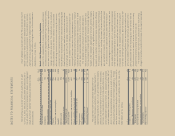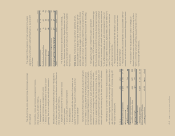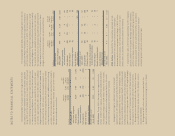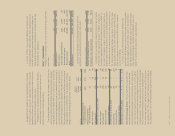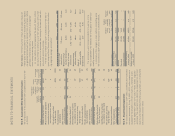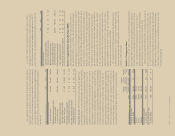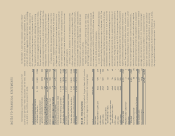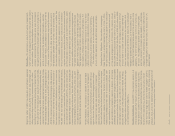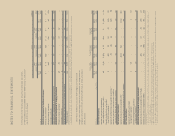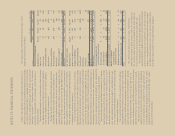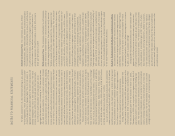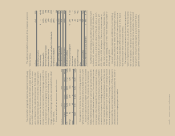Sara Lee 2011 Annual Report Download - page 106
Download and view the complete annual report
Please find page 106 of the 2011 Sara Lee annual report below. You can navigate through the pages in the report by either clicking on the pages listed below, or by using the keyword search tool below to find specific information within the annual report.
NOTES TO FINANCIAL STATEMENTS
Currency Forward Exchange, Futures and Option Contracts
The corporation uses forward exchange and option contracts to
reduce the effect of fluctuating foreign currencies on short-term
foreign-currency-denominated intercompany transactions, third-party
product-sourcing transactions, foreign-denominated investments
(including subsidiary net assets) and other known foreign currency
exposures. Gains and losses on the derivative instruments are
intended to offset losses and gains on the hedged transaction in
an effort to reduce the earnings volatility resulting from fluctuating
foreign currency exchange rates. Forward currency exchange con-
tracts which are effective at hedging the fair value of a recognized
asset or liability are designated and accounted for as fair value
hedges. Forward currency contracts that act as a hedge of changes
in the underlying foreign currency denominated subsidiary net assets
are accounted for as net investment hedges. All remaining currency
forward and options contracts are accounted for as mark-to-market
hedges. The principal currencies hedged by the corporation include
the European euro, British pound, Danish kroner, Hungarian forint,
U.S. dollar, Australian dollar and Brazilian real. The corporation
hedges virtually all foreign exchange risk derived from recorded
transactions and firm commitments and only hedges foreign
exchange risk related to anticipated transactions where the
exposure is potentially significant.
Commodity Futures and Options Contracts
The corporation uses
commodity futures and options to hedge a portion of its commodity
price risk. The principal commodities hedged by the corporation
include hogs, beef, natural gas, diesel fuel, coffee, corn, wheat and
other ingredients. The corporation does not use significant levels
of commodity financial instruments to hedge commodity prices
and primarily relies upon fixed rate supplier contracts to determine
commodity pricing. In circumstances where commodity-derivative
instruments are used, there is a high correlation between the com-
modity costs and the derivative instruments. For those instruments
where the commodity instrument and underlying hedged item corre-
late between 80-125%, the corporation accounts for those contracts
as cash flow hedges. However, the majority of commodity derivative
instruments are accounted for as mark-to-market hedges. The corpo-
ration only enters into futures and options contracts that are traded
on established, well-recognized exchanges that offer high liquidity,
transparent pricing, daily cash settlement and collateralization
through margin requirements.
Contingent Debt Obligations and Other
The corporation has
guaranteed the payment of certain third-party debt. The maximum
potential amount of future payments that the corporation could be
required to make, in the event that these third parties default on their
debt obligations, is $12 million. At the present time, the corpora-
tion does not believe it is probable that any of these third parties
will default on the amount subject to guarantee.
In 2010, the corporation recognized a $26 million charge for
a Mexican tax indemnification related to the corporation’s direct
selling business that was sold in 2006.
Note 15 – Financial Instruments
Background Information The corporation uses derivative financial
instruments, including forward exchange, futures, options and swap
contracts, to manage its exposures to foreign exchange, commodity
prices and interest rate risks. The use of these derivative financial
instruments modifies the exposure of these risks with the intent to
reduce the risk or cost to the corporation. The corporation does not
use derivatives for trading or speculative purposes and is not a party
to leveraged derivatives. More information concerning accounting
for financial instruments can be found in Note 2,
Summary of
Significant Accounting Policies.
Types of Derivative Instruments
Interest Rate and Cross Currency Swaps
The corporation utilizes
interest rate swap derivatives to manage interest rate risk, in order
to maintain a targeted amount of both fixed-rate and floating-rate
long term debt and notes payable. Interest rate swap agreements
that are effective at hedging the fair value of fixed-rate debt agree-
ments are designated and accounted for as fair value hedges. In
2011, the corporation settled $285 million of interest rate swaps,
including a $50 million forward starting swap. The corporation has
a fixed interest rate on approximately 68% of long-term debt and
notes payable issued.
The corporation has issued certain foreign-denominated debt
instruments and utilizes cross currency swaps to reduce the vari-
ability of functional currency cash flows related to the foreign
currency debt. Cross currency swap agreements that are effective
at hedging the variability of foreign-denominated cash flows are
designated and accounted for as cash flow hedges.


